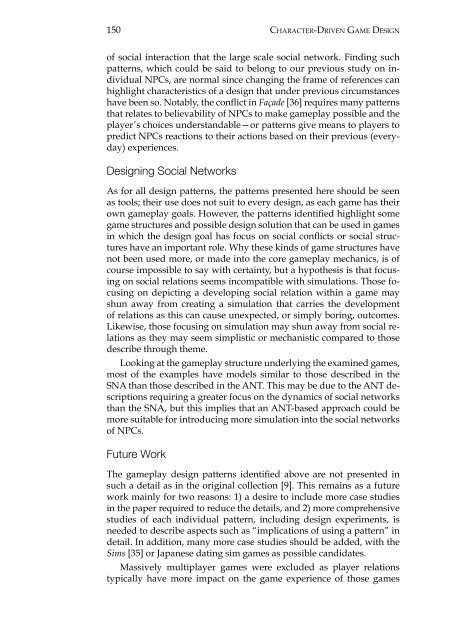Character Driven Game Design
Character Driven Game Design
Character Driven Game Design
You also want an ePaper? Increase the reach of your titles
YUMPU automatically turns print PDFs into web optimized ePapers that Google loves.
150<br />
<strong>Character</strong>-<strong>Driven</strong> <strong>Game</strong> <strong>Design</strong><br />
of social interaction that the large scale social network. Finding such<br />
patterns, which could be said to belong to our previous study on individual<br />
NPCs, are normal since changing the frame of references can<br />
highlight characteristics of a design that under previous circumstances<br />
have been so. Notably, the conflict in Façade [36] requires many patterns<br />
that relates to believability of NPCs to make gameplay possible and the<br />
player’s choices understandable—or patterns give means to players to<br />
predict NPCs reactions to their actions based on their previous (everyday)<br />
experiences.<br />
<strong>Design</strong>ing Social Networks<br />
As for all design patterns, the patterns presented here should be seen<br />
as tools; their use does not suit to every design, as each game has their<br />
own gameplay goals. However, the patterns identified highlight some<br />
game structures and possible design solution that can be used in games<br />
in which the design goal has focus on social conflicts or social structures<br />
have an important role. Why these kinds of game structures have<br />
not been used more, or made into the core gameplay mechanics, is of<br />
course impossible to say with certainty, but a hypothesis is that focusing<br />
on social relations seems incompatible with simulations. Those focusing<br />
on depicting a developing social relation within a game may<br />
shun away from creating a simulation that carries the development<br />
of relations as this can cause unexpected, or simply boring, outcomes.<br />
Likewise, those focusing on simulation may shun away from social relations<br />
as they may seem simplistic or mechanistic compared to those<br />
describe through theme.<br />
Looking at the gameplay structure underlying the examined games,<br />
most of the examples have models similar to those described in the<br />
SNA than those described in the ANT. This may be due to the ANT descriptions<br />
requiring a greater focus on the dynamics of social networks<br />
than the SNA, but this implies that an ANT-based approach could be<br />
more suitable for introducing more simulation into the social networks<br />
of NPCs.<br />
Future Work<br />
The gameplay design patterns identified above are not presented in<br />
such a detail as in the original collection [9]. This remains as a future<br />
work mainly for two reasons: 1) a desire to include more case studies<br />
in the paper required to reduce the details, and 2) more comprehensive<br />
studies of each individual pattern, including design experiments, is<br />
needed to describe aspects such as “implications of using a pattern” in<br />
detail. In addition, many more case studies should be added, with the<br />
Sims [35] or Japanese dating sim games as possible candidates.<br />
Massively multiplayer games were excluded as player relations<br />
typically have more impact on the game experience of those games
















